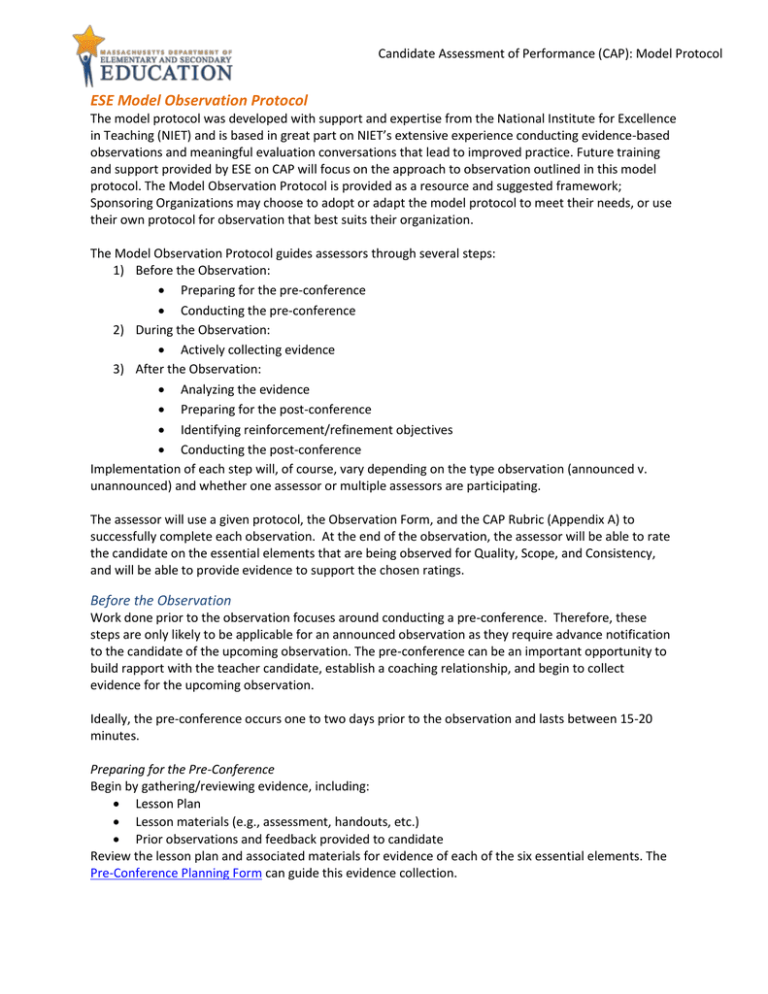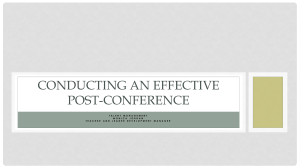ESE Model Observation Protocol
advertisement

Candidate Assessment of Performance (CAP): Model Protocol ESE Model Observation Protocol The model protocol was developed with support and expertise from the National Institute for Excellence in Teaching (NIET) and is based in great part on NIET’s extensive experience conducting evidence-based observations and meaningful evaluation conversations that lead to improved practice. Future training and support provided by ESE on CAP will focus on the approach to observation outlined in this model protocol. The Model Observation Protocol is provided as a resource and suggested framework; Sponsoring Organizations may choose to adopt or adapt the model protocol to meet their needs, or use their own protocol for observation that best suits their organization. The Model Observation Protocol guides assessors through several steps: 1) Before the Observation: Preparing for the pre-conference Conducting the pre-conference 2) During the Observation: Actively collecting evidence 3) After the Observation: Analyzing the evidence Preparing for the post-conference Identifying reinforcement/refinement objectives Conducting the post-conference Implementation of each step will, of course, vary depending on the type observation (announced v. unannounced) and whether one assessor or multiple assessors are participating. The assessor will use a given protocol, the Observation Form, and the CAP Rubric (Appendix A) to successfully complete each observation. At the end of the observation, the assessor will be able to rate the candidate on the essential elements that are being observed for Quality, Scope, and Consistency, and will be able to provide evidence to support the chosen ratings. Before the Observation Work done prior to the observation focuses around conducting a pre-conference. Therefore, these steps are only likely to be applicable for an announced observation as they require advance notification to the candidate of the upcoming observation. The pre-conference can be an important opportunity to build rapport with the teacher candidate, establish a coaching relationship, and begin to collect evidence for the upcoming observation. Ideally, the pre-conference occurs one to two days prior to the observation and lasts between 15-20 minutes. Preparing for the Pre-Conference Begin by gathering/reviewing evidence, including: Lesson Plan Lesson materials (e.g., assessment, handouts, etc.) Prior observations and feedback provided to candidate Review the lesson plan and associated materials for evidence of each of the six essential elements. The Pre-Conference Planning Form can guide this evidence collection. Candidate Assessment of Performance (CAP): Model Protocol It is important to note that this observation is part of an assessment. To this end, assessors should be cautious prior to the lesson to not dramatically influence or alter the candidate’s plan. Assessors should refrain from providing substantial feedback on the lesson plan prior to the observation. Reviewing the lesson plan and materials in advance serves only to better position the assessors in collecting focused evidence and providing quality feedback after the observation. The planning form also prompts the assessor to draft a set of questions to aid in the conversation that occurs in the pre-conference. The assessor should create questions that are likely to: 1) Generate additional evidence in support of the essential elements 2) Address any aspects of the lesson that may negatively impact of observation The pre-conference is short; to keep the conversation focused assessors should prepare 2-3 questions keeping in mind the goals mentioned above. The following are examples of questions the assessor may plan to ask in a pre-conference: General Questions Tell me about the lesson I will observe. What do you expect students to know and be able to do at the end of the lesson? What kind of background do the students need to have for this lesson? Tell me about any challenges or specific areas of the rubric that you are currently working to strengthen. Is there anything else you would like me to know before the lesson? Standards/Objectives How will you check for student mastery in the lesson? How will the learning objective be communicated to students? How do you plan to connect the lesson to previous learning? What type(s) of thinking will be evident in the lesson? How will students apply this thinking during the lesson? Lesson Structure and Pacing Talk about the lesson structure (beginning, middle, and end). Talk about classroom procedures. How is the lesson structured for students that may progress at different learning rates? Talk about any anticipated learning difficulties that may occur during the lesson. Activities and Materials How do the activities relate to the objective? How will you make the lesson relevant to students? Talk about the grouping that will be used in the lesson to maximize student learning. Talk about the strategies that will be used during the lesson to maximize student understanding. If the observation is being conducted jointly between the Program Supervisor and Supervising Practitioner, the preparation should also be coordinated to ensure that the two observers have a unified focus and set of expectations for the observation. Conducting the Pre-conference Candidate Assessment of Performance (CAP): Model Protocol Ideally, the pre-conference occurs one to two days prior to the observation and lasts between 15-20 minutes. While conducting the pre-conference face-to-face may be preferable, assessors may consider taking advantage of other methods of engaging in pre-conference, such as Skype, Facetime, Google Hangout, etc. A pre-conference should include the following: an introduction, a discussion based on the review of lesson materials, and a summary of next steps. Pre-conference Introduction (2 min) The introduction helps to set the tone and purpose of the pre-conference. While it may appear overly formal it can be valuable in establishing routines that help to keep the conversation focused and brief. Below is an example of one approach to the introduction of a pre-conference: Greeting: “Thanks for taking the time to meet with me. I’m really looking forward to coming into your class on _________” Time: “This discussion should take us about 20 minutes” Set Purpose: “The purpose of our conversation is for you to help me to know what I can expect to see happen during the observation and for you to know what things I am specifically looking for.” Discussion of the Lesson (15 min) Following the brief introduction, the assessor should transition quickly into probing further on the candidate’s intentions and plans for the lesson being observed. It is most productive when the assessor has reviewed the lesson plan prior to this conversation and can ask specific, probing questions about the lesson. The candidate should be doing the majority of the talking during this portion of the preconference. The assessors should be capturing notes on the conversation. Below is an example of one approach to the discussion about the lesson: Reference review of materials: “I reviewed the materials you sent me in advance and think I have a clear sense of the lesson but was hoping you could elaborate on a few points to be sure I understand your plan.” Ask questions: see pre-conference preparation section for examples Pre-conference Closure (3 min) Assessors should leave time at the end of the conference to summarize any takeaways from the conversation as well as align expectations for the upcoming observation. Below is an example of one approach to pre-conference closure: Revisit prior feedback: “After our second observation, we agreed that you would work to [fill in] so I will be looking for evidence of that in the upcoming observation.” Review the focus Essential Elements: “Also, because this is the third observation, I will also be collecting evidence specifically for element 1.B. 2.” Summarize takeaways from the conversation: “Based on what you shared with me during our conversation, it sounds like you are also looking for feedback on your transitions so I will be sure to make note of those as well.” During the Observation The primary goal of the assessor during the observation is to actively collect evidence. Active evidence collection should capturing both teacher and student behavior/actions. Active evidence collection does not include making judgments or inferences during the observation; this occurs after when the assessors is analyzing and synthesizing the evidence. Evidence should reflect exactly what happens in the Candidate Assessment of Performance (CAP): Model Protocol classroom. Evidence collected should include a balance of both summary statements as well as direct quotes. There are various tools assessors may use to collect evidence during the lesson. This could include scripting, videotaping, audio-recording, or using other commercially available applications that aid in observing specific classroom interactions. Evidence collected during the observation is solely to aid the assessor in identifying trends and selecting illustrative examples of aspects of performance. It is not designed to be shared directly with the candidate nor is it collected by ESE. Individual providers may, however, decide to collect this information from assessors for training or documentation purposes. After the Observation After an observation, assessors review evidence collected and begin to analyze it as a measure of candidate performance and then strategically plan for a post-conference in which candidates are provided with targeted feedback. Ideally, post-conferences occur one to two days following the observation and last between 20-30 minutes. Post-conferences should not occur immediately after the lesson as this does not allow for sufficient time for the assessors to synthesize evidence and feedback or for the candidate to adequately reflect. Sponsoring Organizations may also consider having the candidate submit a written reflection to the assessor(s) prior to the post-conference. See the Candidate Self-Reflection Form. If adding this step, assessors should plan to complete their analysis prior to reviewing the candidate self-reflection. Analyzing & Categorizing the Evidence Following the observation, the assessors should review the evidence collected during the lesson and begin to fill in the evidence chart located in the appropriate Observation Form. When categorizing evidence, assessors should consider the following: Not every piece of evidence collected during the observation needs to be sorted into the evidence chart. Evidence may demonstrate that one or more of the dimensions (Quality, Consistency, Scope) of an element are being met OR that performance is not yet at the expected threshold. It is recommended that you consult the CAP Rubric when categorizing evidence. Evidence statements should not simply reiterate or restate the performance descriptors present in the CAP Rubric; the evidence should explain what happened in the observation that shows/does not show that a skill has been demonstrated. Assessors might consider “tagging” evidence that gets included in the Observation Forms by dimension (quality, scope, consistency) so that it can easily be referred to when making summative judgments. Preparing for the Post-Conference The primary purpose of the post-conference is to provide candidates feedback about their performance during the observation. After categorizing evidence according to the elements, assessors should work to identify specific areas of strength (reinforcement) and areas for improvement (refinement). The PostConference Planning Form can guide the development of this feedback. Candidate Assessment of Performance (CAP): Model Protocol Begin by gathering/reviewing evidence, including: Lesson Plan & Pre-Conference Planning Form Notes from Pre-Conference Observation Form that contains categorized evidence Candidate Self-Reflection Form (if required) For observations that are conducted jointly, the Program Supervisor and Supervising Practitioner should calibrate on the evidence categorized as well as the identification of areas for reinforcement/refinement. This must be done prior to meeting with the candidate to ensure that the candidate receives consistent, calibrated feedback about their performance. Candidate Assessment of Performance (CAP): Model Protocol Identifying Reinforcement and Refinement Areas Assessors are asked to identify for the candidate areas of strength and areas for improvement. This does not preclude the candidate from self-identifying areas as well. Areas of reinforcement and refinement should be tied directly to the six Essential Elements. Reinforcement: The area of reinforcement should identify the candidate’s instructional strength in a way that encourages the continuation of effective practices in the future. The area of reinforcement should be deep rooted in student-based evidence that demonstrates successful positive impact on student learning. Refinement: The area of refinement should identify the areas in need of instructional improvement. In reflecting on the analysis of the evidence, assessors should select one to two (but no more than three) reinforcement and refinement areas. Assessors are encouraged to select the reinforcement and refinement areas that are most likely to improve candidate practice and have a positive impact on student learning. The refinement/reinforcement objectives can focus on the Quality, Consistency or Scope dimension of an element. However, assessors should not set refinement or reinforcement goals around Consistency or Scope until the candidate has successfully met the Quality threshold. There are several guiding questions and considerations that can support the identification of the effective reinforcement/refinement areas: Which areas on the CAP rubric received the highest ratings (reinforcements) and the lowest ratings (refinements)? Which of these areas would have the greatest impact on student achievement? Which of these areas would have the greatest impact on other areas of the rubric? In which area does the candidate have the most potential for growth? Make sure that the reinforcement is not directly related to the refinement. It is important that candidates see their area of strength as separate from their area needing improvement. Choose a refinement area for which you have sufficient and specific evidence from the lesson to support why the teacher needs to work in this area. Select refinement topics around which you are prepared to provide specific support. There is nothing worse than telling a teacher they need to alter their practice and then not being able to provide specific examples for how this can be done. Understand the teacher’s capacity when identifying an area of refinement. In other words, where will you get the biggest bang for your buck? Remember—reinforcements should be only to strengthen the candidate’s performance. Do not hedge this part of the post-conference with qualifying statements such as “it could have been even better if,” or “next time you could also do…” Teachers need to hear what they are effective at, and have it be left at that. When developing the post-conference plan, consider identifying the area of refinement first. This will ensure that the reinforcement and refinement do not overlap. Once you have identified the areas of refinement/reinforcement fill them in at the bottom of the Observation Form. Candidate Assessment of Performance (CAP): Model Protocol Conducting the Post-Conference Ideally, the post-conference occurs one to two days prior to the observation and lasts between 20-30 minutes. While conducting the post-conference face-to-face may be preferable, assessors may consider taking advantage of other methods of engaging in pre-conference, such as Skype, Facetime, Google Hangout, etc. Post-conferences should not occur immediately after the lesson as this does not allow for sufficient time for the assessors to synthesize evidence and feedback or for the candidate to adequately reflect. A post-conference should include the following: an introduction, a discussion of reinforcement/refinement areas, and a summary of next steps. Post-conference Introduction (5 min) The introduction helps to set the tone and purpose of the post-conference. While it may appear overly formal it can be valuable in establishing routines that help to keep the conversation focused and brief. Below is an example of one approach to the introduction of a post-conference: Greeting: “Thanks for taking the time to meet with me. I’m really looking forward to our discussion on the lesson I was able to see in action. ” Time: “This discussion should take us about 30 minutes” Set Purpose: “The purpose of our conversation is for us to identify both strengths and areas of improvement in your practice” Probe for self-reflection: “What are your thoughts about how the students responded to the lesson?” OR if the candidate already completed the self-reflection form, “I saw from your reflection that…” Discussion of Reinforcement/Refinement Areas (20 min) The discussion about strengths and areas for improvement should begin with outlining the areas of reinforcement and then transition to the areas of refinement. The assessor should provide specific examples from the observation as evidence of the area of refinement or reinforcement. Below is an example of one approach to the discussion: Share areas of Reinforcement: o Provide evidence from observation: “There were several instances throughout the lesson where you asked a variety of questions to check for student understanding. For example, after showing the pictograph you…” o State impact on students: “In doing so, students were required to justify their thinking and it allowed you to quickly identify misconceptions in students understanding.” o Provide recommended action: “Continue to…” Share areas of Refinement: o Ask self-reflection question: Ask a specific question to prompt the teacher to talk about what you want him or her to improve. Utilize a question that includes specific language from the rubric, which can lead the teacher to reflect on the indicator you have identified as his/her area of refinement as it relates to the lesson. Example: “When developing lessons, how do you decide on the pacing of the lesson so sufficient time is allocated for each segment?” o Share evidence from observation: “You mentioned earlier that you wanted students to be able to work in groups and then report their findings. However, there was not Candidate Assessment of Performance (CAP): Model Protocol o o o sufficient time for this to occur during the lesson. According to the observation log, the first 6 minutes was spent organizing materials and transiting students; the next 23 minutes was spent with you modeling the objective at the board with some questions and answer time built in.” Provide concrete suggestions for how to improve: “As you modeled how to analyze a pictograph, students could have worked with their group members to answer your questions prior to your providing the answer, then they could have reported to the class their findings. This would have still allowed you to model, but would have also allowed students to work together to analyze the pictograph. Students who may not have required this review could have worked independently in a group to analyze their own pictograph while the rest of the class participated in your modeling. This would have also allowed you to differentiate the pacing of the lesson to provide for students who progress at different learning rates. This lesson could also have been segmented into two different lessons.” Provide recommended action: “Moving forward…” Share resource/support: “As you work to further refine this skill, I think it might be helpful if you go and observe Mrs. Blank in 3rd grade who is highly-skilled in this area. I’ve already spoken with her and she has agreed to an observation and debrief next week.” Post-conference Closure (5 min) Evaluators should leave time at the end of the conference to summarize any takeaways from the conversation. Below is an example of one approach to post-conference closure: Share Observation Form: “I’ve categorized the evidence from observation as well as recorded the reinforcement and refinement areas and actions here” (Alternatively, you may have the candidate fill in the refinement/reinforcement goals based on the discussion. Evaluators should, however, be sure that it is an accurate reflection of the intended objectives for refinement/reinforcement.) Leave time for questions: “Do you have any other questions?” Confirm next steps in process: “The next formal observation will be unannounced and conducted by your Supervising Practitioner. Because it is the second observation she will be focusing evidence collection on the refinement goals we discussed today as well as essential elements 1.A.4 and 2.B.1.








